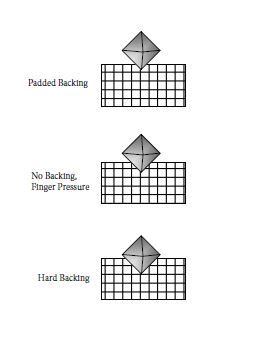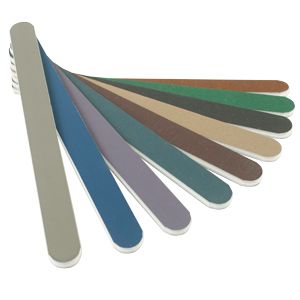Also, a quick word of caution on using hard backings for abrasives. While I can see the appeal of using a hard backed abrasive when removing tooth chatter or other flaws as is sometimes necessary, I would caution against using a hard backing when moving on to the polishing phase of stem refurbishing. Grit penetration of the work surface can be as much determined by the backing as by the choice of abrasive itself. A lot of flaw removal is about removing stock from the work piece to create a more "blended" look to the surface. Polishing is more about smoothing the surface scratches on the work piece while minimizing the creation of new ones.
A hard backing like wood or a hard rubber block is great for cutting action (gouging the surface) of a work piece but tends to be too aggressive for polishing. When force/pressure is applied to a surface, that surface wants to "resist" the force and return some of it back in the direction of application. A hard backing doesn't allow much "give" and the grit maintains a high level of penetration into the surface. This high level of penetration promotes the cutting of new furrows in the surface, i.e. removes stock, which is counter productive to the goal of surface smoothing.
When an abrasive is used, it cuts a series of "peaks" and "valleys" into the work surface. These peaks and valleys create a very dull looking surface due to the laws of refraction. The goal of polishing is to "wear away" these peaks without deepening the low spots any further. A hard backing keeps the particles pushed into the surface as deep as possible running the risk of cutting the low spots even deeper, rather than simply smoothing out the high spots.
No backing at all is much preferable to a hard backing but still isn't the most ideal. When using finger pressure you can actually feel the surface resisting the applied pressure. This "tactile feedback" will almost invariably cause someone to unconsciously press down on the abrasive even harder, again causing the particles to penetrate further than is necessary for a smoothing effect.
A padded backing is most ideal for polishing a surface. This type of backing will allow some "float back" of the grit which will help keep the particles out of the low spots while still allowing them to wear away at the high spots. This will minimize stock removal and will actually give a higher gloss to the surface in a shorter amount of time due to having to spend less time per grit, making it a much more efficient technique.
Below is a diagram I threw together, certainly not meant to be perfectly accurate or to scale, lol, but it does illustrate the concept of the grit penetration of different backing types.









